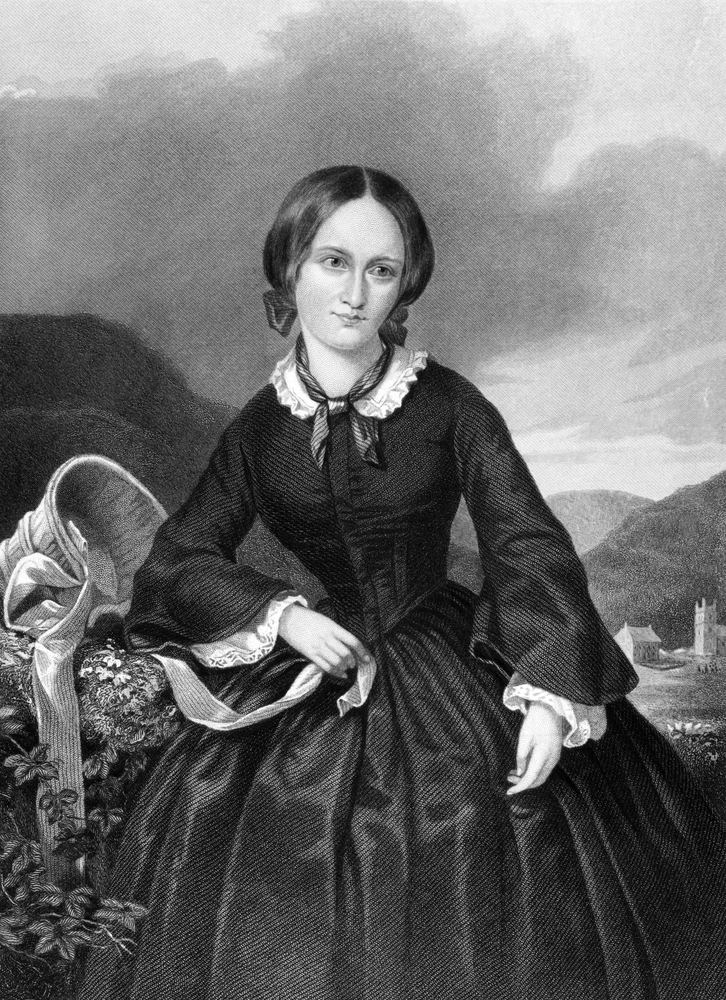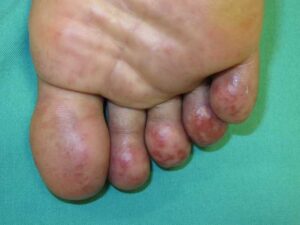Right after I posted the frostbite article, https://novelmalpractice.com/novel-malpractice-writing-about-frostbite/ another writer on Facebook asked how chilblains was related.
Talk about right on the money!
Dickens wrote about chilblains, as did another favorite author, Charlotte Bronte, in Jane Eyre. The POV character Jane writes about getting chilblains in the charity school for orphans, Lowood, during winter. (Is “Low wood” a pun by Bronte?)
“Our clothing was insufficient to protect us from the severe cold: we had no boots, the snow got into our shoes and melted there: our ungloved hands became numbed and covered with chilblains, as were our feet . . .” Jane Eyre, by Charlotte Bronte
Modern writer Jo Baker in Longbourn, her Pride & Prejudice prequel, goes into greater detail about how the housemaids suffer from chilblains, due to repeated cold water on their hands as they do chores. She goes on to mention those who walked outdoors in cold, damp weather also suffered them on their feet. Chilblains affects what are called “acral” areas – toes, fingers, nose, and ears.

It was common in past eras where poverty was severe and winter heating inadequate, but did you know chilblains are MORE common in temperate areas? Citizens in countries with tough cold winters are prepared with proper housing and clothing, plus the air tends to be drier. Peak chilblains seasons for wet climates and temperatures above freezing are usually late winter and early spring,
https://austenprose.com/2013/10/16/longbourn-a-novel-by-jo-baker-a-review/
Other literary references to chilblains:
-
Charles Dickens – A Christmas Carol (1843)
Dickens often mentioned struggles of the poor in Victorian England. Chilblains are seen as a common affliction of those suffering in the cold. In A Christmas Carol, Bob Cratchit’s cold exposure due to Scrooge’s limiting his use of coal for a fire in the office stove. -
Emily Brontë – Wuthering Heights (1847)
The novel describes the harsh Yorkshire winters. Joseph, the stern servant, is mentioned suffering from chilblains. -
Louisa May Alcott – Little Women (1868)
In Little Women, the March sisters endure the hardships of a frigid Yankee winter, and their limited means make them vulnerable to conditions like chilblains. -
Thomas Hardy – Tess of the D’Urbervilles (1891)
Hardy often described the physical toll of poverty and labor. In this novel, the difficult winter conditions Tess faces while working outside on a farm make her susceptible to chilblains. -
George Orwell – Down and Out in Paris and London (1933)
Orwell’s semi-autobiographical book describes the hardships of poverty, including the effects of exposure, malnutrition, and cold, which often led to diseases like chilblains.
What are Chilblains?
Also called PERNIO, chilblains are related to frostbite because they are both cold-related illnesses. In frostbite, the tissue actually freezes. Chilblains could best be described as repeated frostnip that causes chronic symptoms and skin changes. They’re caused when the skin reacts to cold exposure of several hours. Frostbite occurs at temperatures at or below freezing 32° F (0°C) while chilblains is seen at cold temperatures above 33° F (1° C).
Small blood vessels constrict in the area of cold, which keeps warm blood from bringing fresh oxygen into the tissues – usually fingers and toes – until they warm up. When that happens, the plasma portion of blood – what you see as clear serum in a blood clot tube – leaks out underneath the skin and creates swelling. Which then sets up a vicious cycle, because the pressure of the swelling squeezes the blood vessels and slows blood flow even more.
Chilblains is a self-limited condition that usually resolves within 1-3 weeks.
If cold exposure is repeated, chronic chilblains can develop.
Did you know?
Chilblains comes from combining two Old English words:
“chill” ( cold ) and “blegen” (sore)
Chilblains can affect any area of chronically cold exposed skin, such as the thighs and hips of horse riders, called “Equestrian Panniculitis” (Panni- refers to subcutaneous fat).
SYMPTOMS OF CHILBLAINS
- Red to purple itchy spots or even painful
- Burning and itching which worsens with entering a warmer area
- Swelling – which can lead to skin cracking
- Blistering
- Sores and ulcers (severe cases), pus would indicate infection
- Usually acute
- Risk factors often not present, so they can be “idiopathic” meaning no idea why
PRIMARY (IDIOPATHIC) CHILBLAINS – when no other cause is found
SECONDARY CHILBLAINS – when another associate problem is behind the chilblains, like lupus
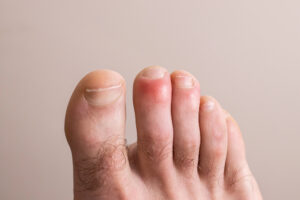
Chilblains on toes
Risk Factors for Chilblains:
Questions you need to ask yourself as a writer are – does my character have (or need) a risk factor?
What is their age (as usual, kids and the elderly are more prone to chilblains)?
Occupation? Environment?
- Smoking raises the risk – smoking causes small blood vessels to constrict
- People with anemia
- Bunions which cause pressure inside the shoes and reduce blood flow
- Anyone with poor circulation
- Participation in ice-related sports or outdoor sports involving cold weather/snow
- Females more likely to develop it than men, due to less protective muscle layers
- Hormonal issues like low thyroid (hypothyroidism)
- Outdoors work and occupations, especially farmers, fishermen, linemen, etc. Firefighters, police and first responders usually wear adequate weather protection.
CERTAIN MEDICINES CAN CAUSE VASOCONSTRICTION!
- Inherited family tendency to chilblains
- Low body mass (BMI) has less protective fat and muscle, so lean people are more prone
- Poor nutrition, starvation make someone more likely to get chilblains
- Bone marrow diseases like CML, chronic myelocytic leukemia, myelofibrosis, etc. increase the risk
- Having Raynaud’s syndrome (autoimmune disorder that cause pain/discoloration in fingers upon cold exposure)
- Acrocyanosis – a peripheral vascular disease that causes persistently blue or dusky mottling of hands and/or feet (see link below)
- Peripheral vascular disease linked to diabetes or heart or kidney diseases
- Underlying autoimmune or connective tissue disorders – especially LUPUS ERYTHEMATOSUS
CHILBLAIN LUPUS ERYTHEMATOSUS (CHLE)
TREATMENT OF CHILBLAINS:
- Prevention is the best treatment here: warm clothing, adequate covering out in the cold, keeping the entire body warm, keeping indoors dry and warm, avoiding cold & wet environments, soaking hands in warm water before exposing them to cold, not smoking, stopping medicines that would put you at risk.
- Topical care: avoid scratching or itching – if your character does this, they risk opening up a sore which can then get infected. (Obviously, young children are more likely to not follow these directions!)
- Medicines can be prescribed by the doctor such as ointments or even vasodilator drugs
- Keeping the areas moisturized with shea butter, lanolin, etc.
- If ulcers develop, an antiseptic dressing is recommended
- In the UK, a pharmacist can make up a mixture of Friar’s Balsam and a weak solution of iodine which can be used
- In some cases, a skin biopsy may be needed to establish the diagnosis and rule out other skin conditions
COVID TOES
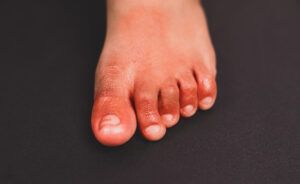
Painful red inflammation on toe called covid toe lesions strange sign of new coronavirus symptoms or infections.
This wouldn’t be complete without a mention of COVID toes – which of course, is MODERN and not historical! Covid toes occur mostly in young children to teens infected with Covid-19 SARS. You can see why it could easily be confused with chilblains, and the symptoms are identical, too. This condition resolves on its own without treatment in one to three weeks.
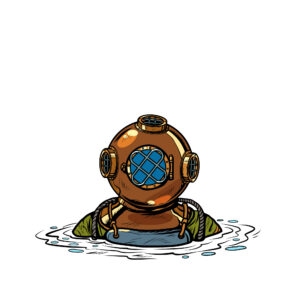
DEEPER HISTORICAL DIVES:
https://novelmalpractice.com/writing-about-hypothermia/
https://dermnetnz.org/topics/acrocyanosis
https://pmc.ncbi.nlm.nih.gov/articles/PMC3255185/
LINK to buy LONGBOURN: https://www.amazon.com/Longbourn-Jo-Baker/dp/0345806972/

